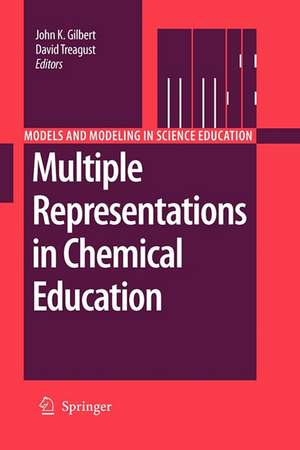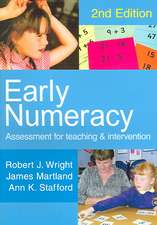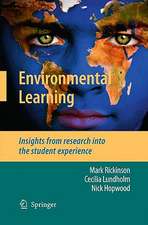Multiple Representations in Chemical Education: Models and Modeling in Science Education, cartea 4
Editat de John K. Gilbert, David Treagusten Limba Engleză Paperback – 28 oct 2010
| Toate formatele și edițiile | Preț | Express |
|---|---|---|
| Paperback (1) | 948.47 lei 6-8 săpt. | |
| SPRINGER NETHERLANDS – 28 oct 2010 | 948.47 lei 6-8 săpt. | |
| Hardback (1) | 954.62 lei 6-8 săpt. | |
| SPRINGER NETHERLANDS – 9 mar 2009 | 954.62 lei 6-8 săpt. |
Preț: 948.47 lei
Preț vechi: 1156.67 lei
-18% Nou
Puncte Express: 1423
Preț estimativ în valută:
181.48€ • 189.49$ • 150.21£
181.48€ • 189.49$ • 150.21£
Carte tipărită la comandă
Livrare economică 04-18 aprilie
Preluare comenzi: 021 569.72.76
Specificații
ISBN-13: 9789048180134
ISBN-10: 9048180139
Pagini: 380
Ilustrații: X, 367 p. 58 illus.
Dimensiuni: 155 x 235 x 20 mm
Greutate: 0.53 kg
Ediția:Softcover reprint of hardcover 1st ed. 2009
Editura: SPRINGER NETHERLANDS
Colecția Springer
Seria Models and Modeling in Science Education
Locul publicării:Dordrecht, Netherlands
ISBN-10: 9048180139
Pagini: 380
Ilustrații: X, 367 p. 58 illus.
Dimensiuni: 155 x 235 x 20 mm
Greutate: 0.53 kg
Ediția:Softcover reprint of hardcover 1st ed. 2009
Editura: SPRINGER NETHERLANDS
Colecția Springer
Seria Models and Modeling in Science Education
Locul publicării:Dordrecht, Netherlands
Public țintă
ResearchCuprins
Introduction: Macro, Submicro and Symbolic Representations and the Relationship Between Them: Key Models in Chemical Education.- The Challenges Faced in Teaching and Learning About the Representational Triplet.- Learning at the Sub-micro Level: Structural Representations.- Micro–Macro Thinking in Chemical Education: Why and How to Escape.- Towards a Better Utilization of Diagrams in Research into the Use of Representative Levels in Chemical Education.- Learning at the Symbolic Level.- Improving Existing Pedagogy in Respect of the Triplet Relationship.- Learning at the Macro Level: The Role of Practical Work.- Linking the Macroscopic, Sub-microscopic and Symbolic Levels: The Case of Inorganic Qualitative Analysis.- The Efficacy of an Alternative Instructional Programme Designed to Enhance Secondary Students’ Competence in the Triplet Relationship.- Linking the Macroscopic and Sub-microscopic Levels: Diagrams.- Classroom Solutions to the Challenges Posed by the Triplet Relationship.- Structure–Property Relations Between Macro and Micro Representations: Relevant Meso-levels in Authentic Tasks.- Historical Material in Macro–Micro Thinking: Conceptual Change in Chemistry Education and the History of Chemistry.- The Roles of Multimedia in the Teaching and Learning of the Triplet Relationship in Chemistry.- The Application of a ‘Model of Modelling’ to Illustrate the Importance of Metavisualisation in Respect of the Three Types of Representation.- Action Research to Promote the Formation of Linkages by Chemistry Students Between the Macro, Submicro, and Symbolic Representational Levels.- Towards a Coherent Model for Macro, Submicro and Symbolic Representations in Chemical Education.
Textul de pe ultima copertă
Chemistry seeks to provide qualitative and quantitative explanations for the observed behaviour of elements and their compounds. Doing so involves making use of three types of representation: the macro (the empirical properties of substances); the sub-micro (the natures of the entities giving rise to those properties); and the symbolic (the number of entities involved in any changes that take place). Although understanding this triplet relationship is a key aspect of chemical education, there is considerable evidence that students find great difficulty in achieving mastery of the ideas involved. In bringing together the work of leading chemistry educators who are researching the triplet relationship at the secondary and university levels, the book discusses the learning involved, the problems that students encounter, and successful approaches to teaching. Based on the reported research, the editors argue for a coherent model for understanding the triplet relationship in chemical education.
Caracteristici
Addresses to key aspect of chemical education Reviews of evidence of student problems in learning Discussion of chemistry curriculum Includes case studies of successful teaching methods Discusses innovative approaches to teaching

























